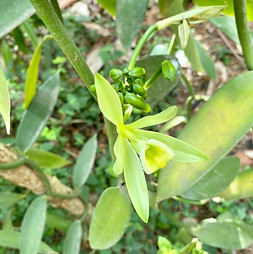
How it is made
Vanilla work is a long and meticulous process. Extracting the quintessence of this exceptional product requires constant, rigorous monitoring and daily handling of each pod throughout this delicate process called "preparation", which alone justifies the market value of vanilla. Combining patience, rigor and know-how is our trademark here.
To bring out the characteristic smell of vanilla, they must undergo a treatment to release vanillin. The transformation of these fruits, hitherto perfectly odorless, into a soft and pleasantly scented spice requires meticulous and methodical preparation, the principles of which are as follows:
The preparation begins with a brutal shock (scalding) which aims to "kill" the vanilla pod. Then follows a series of processing, drying and sorting operations that lasts nearly eight months, before ending up with the marketable vanilla pod, ready for export.
Preparation with hot water is to favor the formation of the perfume, to give the pods a good appearance, to prevent their dehiscence and to make them suitable for keeping well.
Step one: Flowering

Vanilla is a plant that is part of the orchid family, originally from Mexico and introduced to Madagascar in 1871 by planters from Reunion.
The variety of vanilla grown in Madagascar is Vanilla Planifolia whose vine grows in the shade of shade trees around a non-organic stake.
Around the months of September and October the first flowers appear, fertilized afterwards by the hand of man. The "matchmakers" have only a few days to intervene.
Step 2: Pollination

The "matchmakers" are the women responsible for carrying out the ancestral and delicate acts of pollination. They can fertilize between 1000 to 1500 flowers per day during the short flowering period. It is thanks to the invention of manual pollination that vanilla pods appear.
Step 3: Harvesting green vanilla

It will take 9 months for the pods to appear and grow on the vines, and for the clusters to form.
Once the maturity of the pods has been reached, the harvest by the planters begins in July and marks the start of the season.
Step 4: Scalding & Steaming
Step 5: Drying
Step 6: Sorting, selection & quality control

Scalding consists of immersing the green pods in heated water around 75°, for about 1 minute to 2 minutes. This ensures the transformation of glucovanillin into the potential vanillin of the pods.
During parboiling, the smoking pods are then placed in large wooden boxes, padded with blankets and sheaths to continue to preserve the heat of the pods. It is at this stage that the pod gradually develops its brownish color

The precious pods are then distributed on drying racks
The racks are then placed in the sun for a few weeks and finally in the shade.

It is at this stage that the verifiers exercise their expertise, a know-how which is transmitted from generation to generation. They are the guardians of a tradition that preserves the quality, aroma and appearance of vanilla beans.
At the various stages of preparation, quality teams take care to take samples which will be tested in laboratories.
The related data makes it possible to monitor and guarantee food safety as well as the organoleptic profile of the pods.
Step 7: Packaging & export

Once stabilized, the vanilla pods are bundled by quality and length.
For export, the vanilla pods are placed in boxes, covered with wax paper. This arrangement makes it possible to protect the pods during the journey and despite the climatic conditions on their arrival.


